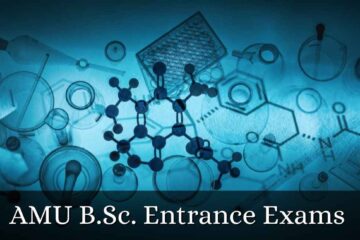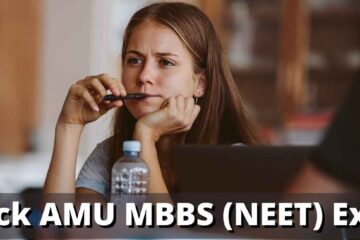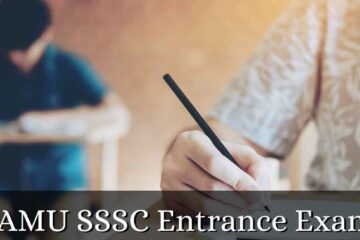Introduction: How to crack AMU B.Sc. Entrance Exam

The Faculty of Science of AMU conducts the entrance exam for the B.Sc. courses. This course is offered by many departments such as Physics, Chemistry, Biology, Botany, Zoology, Mathematics, Geography, Geology, Statistics, Industrial Chemistry, Biochemistry, and Computer Application.
Here the competition is tougher and a little harder to get your favorite subject as the main Subject. Hence, every student must score high in the entrance exam to get selected on the first list. For this, the aspirants can use the following tips and can follow these given steps which may help them to crack AMU B.Sc. Entrance Exam.
Also Check: How to crack the AMU SSSC Entrance Exam.
Know the Syllabus in detail.
Understand the Exam Pattern and Marking scheme.
Get Basic Preparation books.
Create a Monthly and Weekly timetable.
Makes important & short Notes and revises them regularly.
Go through Previous Years Question papers.
Give Mock Tests and sample papers.
Few references books & preparation guides.
1. Know the Syllabus in detail
The first step to succeed in AMU B.Sc. Entrance Exam, you must know the syllabus of exam. You have to understand the each & every topic of the syllabus. If you are aware of the syllabus, you will able to know; what to study and how much you have to read and how much you have to leave or particular exam.
Brief Syllabus of B.Sc. AMU
ENGLISH 1. One unseen passage with a variety of questions 2. Vocabulary 3. Grammar (i) Tenses, Clauses, gap-filling, error-correction of words and sentences.
PHYSICS 1. Physical World and Measurement 2. Kinematics 3. Laws of Motion 4. Work, Energy & Power 5. The motion of System of Particles & Rigid Body 6. Gravitation 7. Properties of Bulk Matter 8. Thermodynamics 9. Behavior for Perfect Gas & Kinetic Theory of gases 10. Oscillations & Waves 11. Electrostatics 12. Current Electricity 13. Magnetic effect of current & Magnetism 14. Electromagnetic Induction and Alternating current 15. Electromagnetic Waves 16. Optics 17. Dual Nature of Matter 18. Atoms and Nuclei 19. Electronic Devices 20. Communication System
MATHEMATICS 1. Sets 2. Relations and Functions 3. Mathematical Induction 4. Complex Numbers 5. Linear Inequalities 6. Quadratic Equations 7. Sequences and Series 8. Trigonometric Functions 9. Cartesian System of Rectangular Coordinates 10. Straight Lines and Family of Straight Lines 2 11. Circles 12. Conic Section 13. Permutation and Combination 14. Binomial Theorem 15. Mathematical Reasoning 16. Statistics 17. Three Dimensional Geometry 18. Vectors 19. Matrices and Determinants 20. Probability 21. Function, Limits, and Continuity 22. Differentiation 23. Application of Derivatives 24. Indefinite Integrals 25. Definite Integral 26. Differential Equations 27. Applications of Integrals 28. Linear Programming
2. Understand the Exam Pattern and Marking scheme
After knowing the syllabus, you must understand the Exam Pattern of B.Sc. Entrance Exam. This will help you to get an idea f the overall structure of the exam.
There shall be one objective type paper of 100 marks with the following components:
Section I English: 25 Marks
Section Il Chemistry: 25 Marks
Section Ill Physics: 25 Marks
Section IV Maths: 25 Marks
Section V Biology: 25 Marks
Section VI Home Science: 25 Marks
Note: Sections I, II, and III are compulsory. Candidates will have the choice to attempt any one Section from IV and V.
3. Get Basic Preparation books
To crack AMU B.Sc. For the entrance exam, you have to select your study material very carefully. If you don’t do this, your chances of selection will be decreased. Aspirants need to make a list of some basic Textbooks (From their XI & XII classes) for preparation for the AMU entrance exam. Candidates should start their preparation by studying NCERT Textbooks used AMU academics.
After completing NCERTs and Basic Textbooks of previous classes, a candidate can move on to preparation books or guides. Aspirants are advised to purchase at least one/two preparation books or guides for AMU Entrance Exams according to applied courses. Students are advised to avoid reading multiple books, i.e. don’t read too many guides or reference books. Some important books are mentioned at the end of the article
4. Create a Monthly and Weekly Time-table
Aspirants require preparing a timetable on what topics to cover when, which topics/subjects require high priority, and how much to cover on a daily, weekly, and monthly basis. The benefit of having a daily study schedule is once you are finished with a task, you already know what is next on your schedule.
A proper and good time-table is very helpful s the candidate have to maintain a balance between his studies and other things. There should be breaks between long continuous study hours. They can follow “50/10 or 25/5 – Rule” (50 or 25 mins for study and 10 or 5 mins of break). You have to distribute your time according to your weakness and strengths. There should be proper time for study, food and sleep.
Students are advised to create a daily plan & while making a time schedule, special time slot should be provide for completing the syllabus of applied course. Revise the syllabus and content, attempt as many questions papers, mock tests and previous year papers for better preparation and time should given to all these steps of preparation wisely
5. Makes important & short Notes and revise them regularly
During studying basic texts books of previous classes or NCERT textbooks, students should make or prepare shorts and understandable notes of physics, chemistry, and Maths, which will be asked in entrance exam. Make easy notes by making Flow Charts, Diagrams, Tables and Posters etc. and stick them wherever possible and review them at least two times a day before sleeping.
There should be fixed revision slot of 1-3 hours in your time-table. Revision is a continuous process. You may think you have prepared a particular topic, chapter or subject perfectly but you won’t able be able to retain it unless you revise again and again. It will give you to get perfect on that particular topic or subject. Student can enhance their revision by solving practice questions on the topic from reference books instead. This will help the students to understand the concepts just studied. The students can use easy to digest notes for their preparation for AMU B.Sc. Entrance Exams.
6. Go through Previous Years Question papers
The next step to qualify for the AMU B.Sc. Entrance Exams is to prepare previous year’s papers. During & after making the notes, candidates need to go through the previous year’s question papers (At least 5 years) of exams of applied courses. Learn the pattern of solving questions. This is possible only through regular and constant practice.
There is no better method to know the frames and traps for AMU Entrance Exams than practicing papers from the past years. You will likewise get a thought of how much time you have to solve the whole paper as well as what kind of inquiries can come and how you have to handle them. Solving past year papers will also give you the best idea of level of AMU entrance exams.
Candidates should learn and prepare all questions of previous year papers. There is the repetition of a few questions every year in most Written or Descriptive Entrance Exams. So, you have to learn from the previous year’s question papers. All AMU’s previous year’s question papers of the last 3 years are available on our site. You can download these papers by clicking on the following link.
7. Give Mock Tests & Sample papers
The next step is to give mock tests and practice sample papers. For this, you can buy entrance sample papers of applied courses from any books shop or you can join regular test series (online/coaching) and give mock tests at home online or in coaching. The main benefit of giving mock tests is that the aspirants can analyze their performance in tests. They can check their mistakes, time spent on the individual question, section of exam or whole exam, and suggestions for improvements.
Students should try to crack mock tests or sample papers within a specific time slot. The general mistake made by most aspirants is that they never review what they have solved. Whenever you are solving a mock test, try to analyze the questions or topics you are facing problems with and the areas you are quick to solve. Develop good planning while solving the practice papers. 50% of the questions in the paper have a low difficulty level, so solve them first. Never solve the paper in a row and avoid the questions you face problems or difficulty.
8. Few references books & preparation guides
Objective Physics by DC Pandey
Concepts of Physics – Volume 1 and Volume 2 by HC Verma
Science for Everyone: Aptitude Test Problems in Physics
Objective Chemistry by RPH Editorial
Entrance Chemistry by Bhakta Books
A Textbook of Organic Chemistry for IITJEE
B.SC Maths Group Entrance Exam by Arihant Experts
Mathematics – A Complete Guide by Suraj, Rashmi
Books Objective Life Sciences: MCQs for Life Sciences Examination by Kailash Choudhary, R P Saran, and Ramesh Rallya
Objective Biology by S Verma
Objective English for Competitive Examination by Tata McGraw Hill
Quick Learning Objective General English by RS Aggarwal
Objective General English by S P Bakshi
Home Science (Human Ecology & Family Science) by Sarita Sirohi
Sample Question Papers Home Science Class 12th CBSE by Arihant Experts
CBSE Chapterwise Solved Papers Home Science Class 12th by Gajendra Singh/ Mridula Sharma
Together With Home Science – 12 by Racha Sagar
S.CHAND for biology.
Pradeep’s Chemistry.
Pradeep’s Physics
R.D SHARMA for maths.









